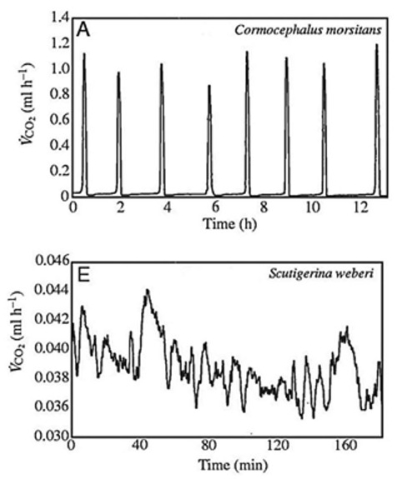Use the following information to answer the question(s) below.
Many terrestrial arthropods exchange gases with their environments by using tracheae, tubes that lead from openings (called spiracles) in the animal's exoskeleton or cuticle directly to the animal's tissues. Some arthropods can control whether their spiracles are open or closed; opening the spiracles allows carbon dioxide produced in the tissues to travel down the tracheae and be released outside the animal. Klok et al. measured the carbon dioxide emitted over time (represented by VCO2) by several species of centipedes. The figure below presents graphs of their results for two species, Cormocephalus morsitans and Scutigerina weberi. (C. J. Klok, R. D. Mercer, and S. L. Chown. 2002. Discontinuous gas-exchange in centipedes and its convergent evolution in tracheated arthropods. Journal of Experimental Biology 205:1019-29.) Copyright 2002 The Company of Biologists and the Journal of Experimental Biology. 
-What would be the most direct effect of removing or damaging an insect's antennae? The insect would have trouble ________.
A) hearing
B) mating
C) eating
D) seeing
E) smelling
Correct Answer:
Verified
Q30: Among the invertebrate phyla, phylum Arthropoda is
Q32: All arthropods _.
1) undergo complete metamorphosis
2) have
Q34: Use the following information to answer the
Q35: Use the following information to answer the
Q36: Use the following information to answer the
Q38: You find a multilegged animal in your
Q39: Which of the following are characteristics of
Q40: Use the following information to answer the
Q44: In a tide pool, a student encounters
Q54: The heartworms that can accumulate within the
Unlock this Answer For Free Now!
View this answer and more for free by performing one of the following actions

Scan the QR code to install the App and get 2 free unlocks

Unlock quizzes for free by uploading documents